Zottegem
Zottegem is a vibrant small town in the southeastern corner of East Flanders. It is considered one of the gateways to the hills of the Flemish Ardennes. This bustling market town is known for its historical ties with Lamoral, Count of Egmont, and for playing host to the Flanders springtime cycle classics.

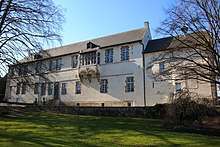
Understand
- Tourist Office, Markt 1, ☎ +32 9 364 64 64, e-mail: toerisme@zottegem.be. M-F: 9:00—12:00, 13:30-16:00. 1 May-15 Sept: M-F: 9:00—12:00 and 13:30—16:00, Sa: 10:00—12:00 and 13:00—15:00 Su: 09:00-13:00. This tourist office will be more than happy to help you out with your questions about the city of Zottegem and the Flemish Ardennes region.
Get in
By train
🌍 Zottegem Railway Station is located centrally in the town.
- Direct connections from Brussels, Ghent, Kortrijk, Geraardsbergen, Oudenaarde. Zottegem is 40 minutes away from Brussels and 30 minutes from Ghent.
By bus
The Flemish national bus company, De Lijn, has lines to Zottegem from Aalst, Oudenaarde, Ronse, Geraardsbergen, Ninove and other neighbouring towns.
By car
Zottegem is on the N42, giving it access to junction 18 'Wetteren' on the E40 Brussels-Ostend motorway and to junction 29 'Lessines' on the E429 Brussels-Tournai motorway. It has regional road links with Oudenaarde and Aalst (N46), Oosterzele and Geraardsbergen (N42), Zwalm (N454) and Brakel (N462).
Get around
Zottegem is a small town and it is perfectly possible to discover the town on foot. However, if you would like to see the surrounding villages and countryside a bike or car is recommended. The area around the town is quite hilly so be prepared to some physical activity if you are getting out there on a bicycle.
See
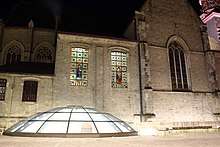
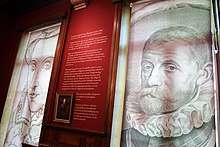
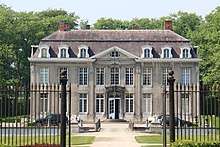
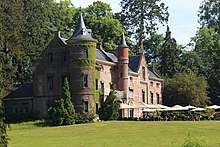
- 🌍 Egmont's castle and Egmont's park, Heldenlaan. The origins of this castle go back to the 11th century. In the 16th century it became one of the luxurious residences of Lamoral, Count of Egmont. The 'Knight's Room' (Ridderzaal) on the east side still has a Renaissance bay window dating from that period. The castle now houses the library and has a neorenaissance facade dating from 1867. Egmont's castle is surrounded by Egmont's park, in which archaelogical remains of the former castle walls, moats and drawbridge can be seen. One of the two statues of Lamoral Count of Egmont stands in front of the castle.
- 🌍 Town Hall and Egmont's museum, Markt 1. The Zottegem town hall on the market square is one of the most characteristic buildings of the town. It dates back to the medieval ages but has been damaged and restored multiple times since; the present town hall was built in 1862. In the town hall one can visit the Egmont museum (Egmontkamer) which showcases historical objects about this 16th-century nobleman who was beheaded by order of the Spanish king Philip II on the Grand-Place in Brussels in 1568. In the adjacent hall one can admire two historical paintings related to Egmont: 'Last Honours to Counts Egmont and Horne' by Louis Gallait (1882) and 'The Castle of Egmond aan den Hoef' (1570) by Gilles De Saen. A shrine containing Egmont's crushed vertebral cervica is also on display. The town hall also houses the tourist office and the centre for regional history.
- 🌍 Egmont's crypt and the Church of the Assumption of Our Lady, Markt. The burial place of Lamoral, Count of Egmont and his wife Sabina, Duchess of Bavaria was rediscovered in 1804 underneath the Church of the Assumption of Our Lady. The crypt contains the mortal remains of Egmont and his wife; three heart-shaped leaden boxes contain the hearts of Egmont and two of his sons. The crypt is covered by a glass dome; a multimedia display tells the story of Egmont and Zottegem in the 16th century.
- 🌍 Egmont's statue, Markt. The statue of Lamoral, Count of Egmont (made by sculptor Calloigne) was erected in 1862 in the middle of the market square in honour of the 16th-century statesman. The present-day bronze statue is a copy of the original one and was erected in 1968; the original cast-iron statue was placed in Egmont's park in front of Egmont's castle.
- 🌍 Sanitary building and Steam Engine museum, Gustaaf Schockaertstraat. The building of the former 'Sanitary Underwear Company' was built in 1909 as one of the first concrete buildings in continental Europe. The renovated building now houses the city's administrative centre and is a fine example of industrial archaeology. The 'Steam Engine museum' displays the Lancashire steam engines that were used in the former factory.
- Art nouveau and Art deco buildings, city centre. In the city centre there are still some buildings that clearly show Art nouveau influences such as stained glass windows and tiles displaying floral motifs (Stationsstraat: numbers 20 (Schildershuis), 45 (Huis van De Sande), 48, 50 (Pâtisserie De La Gare)/ Hoogstraat: 18 (Art deco window 'Little Red Riding Hood'), 39 (floral tiles) / Heldenlaan: 7 (Leon De Smet-Van De Sijpe), 18 (Huis Ferdinand)/ Laurens De Metsstraat: 45, 47, 49, 51/ Kapellestraat: 37/ Léonce Roelsstraat: 11). Some Art deco villas can be seen in and around the city centre (Grotenbergestraat (villas such as Villa Cousy), Bruggenhoek (Villa Cantaert and the villa at Bruggenhoek 44), Zuidstraat).
- Former brewery 'De Klok' ("the Bell"), Laurens De Metsstraat. This building was erected in 1933. The striking bell-shaped dome on top of the building served as a water reservoir for the brewery. The building has been renovated and turned into lofts and apartments.
- Heroes' Monument ('Heldenmonument'), Heldenlaan Avenue. The Heroes' monument, by sculptor Vits, was erected in 1921 in honour of the Zottegem victims of the First World War.
- 🌍 Breivelde castle and Breivelde park, Parkstraat. Breivelde castle was built in 1904. It is surrounded by a public English landscape garden containing ponds and exotic trees.
- 🌍 Leeuwergem castle, Kasteeldreef. Built in 1762, it's one of the finest examples of baroque castle architecture in Belgium. The castle is known for its fine baroque gardens.
- 🌍 Archaeological museum 'Archeocentrum Velzeke (AVE)' and Paddestraat, Paddestraat. The archaeological museum, the provincial archeological centre Velzeke (AVE), is at the northeasterly entrance of the Paddestraat, a cobble-stoned street that was part of the old Roman road from Boulogne-sur-Mer to Cologne (and is nowadays an important part of the cycling classic 'Tour of Flanders'). Many archaeological findings from Gallo-Roman culture, including the bronze Venus of Velzeke, are displayed at the museum, which tells the story of the prehistorical and Roman eras in southeast Flanders. The museum is the starting point for the signposted tourist route 'Viae Romanae' which runs along the old Roman road all the way to the Roman site of Bagacum Nerviorum (Bavay) in northern France. Along the cobble-stoned Paddestraat two historical farms ('Schaliënhof' and 'Hof de Moriaan') can be found.
Do
- Shopping: The main streets in the town centre (Stationsstraat, Hoogstraat, Heldenlaan) offer a wide range of shops and services for all tastes and budgets.
- Dining: The town centre is home to a wide array of bars, pubs, cafés, restaurants, tearooms and eateries.
- Walking: Zottegem offers a wide range of walking routes in the hilly countryside of the Flemish Ardennes. Walkers can use the signposted walking-node networks 'Vlaamse Ardennen - Zwalmvallei' and 'Vlaamse Ardennen - Bronbossen'. The signposted 'Jan de Lichte' walking path along the Molenbeek valley and the former railway-line track 'Mijnwerkerspad' in the Zwalm valley offer great possibilities for walking too. Walkers can also use the signposted walking paths through different nature reserves (Kloosterbos, Middenloop Zwalm, Parkbos-Uilenbroek, Steenbergse bossen, Oombergse bossen-Cotthembos) or can go for a leisurely stroll in one of the local parks (Egmont's park, Beislovenpark, Breivelde park, Pastorietuin Oombergen public garden).
- Cycling: The hilly countryside of the Flemish Ardennes around Zottegem is perfect for sportive cycling tours. Cyclists can use the signposted cycle-node network 'Vlaamse Ardennen', the signposted 'Ronde van Vlaanderenroute' or the former railway-line track 'Mijnwerkerspad' in the Zwalm valley. Some hills (De Vlamme, Langendries, Grotenberge, Kloosterbosstraat, Vossenhol) and cobblestone streets (Paddestraat, Lippenhovestraat) that are part of the springtime Flanders classic cycle races (such as the Tour of Flanders) are located in Zottegem. History lovers can follow the 'Egmontroute' in the footsteps of Lamoral, Count of Egmont.
Buy
Eat
- Koekelaring is one of the culinary specialities of the town; this cinnamon-infused floury bread speciality is sold between December and January.
Drink
Sleep
Connect
- 🌍 Post office, Hoogstraat 67, ☎ +32 22012345. The only post office in Zottegem.